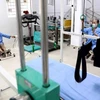A recent survey conducted by the National Institute for Nutrition shows that the average height of Vietnamese men aged between 22-26 is 1.642m (a survey by the Ministry of Health is 1.644m), and 1.534m for women in the same age group.
Despite economic growth lurching forward in the last decade, the average height of Vietnamese people has increased by only 4cm. Compared with the same groups in the Republic of Korea, Japan, Thailand, China and others in South East Asia, the Vietnamese are considered the shortest.
Professor Nguyen Cong Khan from the Health Ministry explained to Tuoi Tre (Youth) newspaper.
* Vietnam's economy in the last several decades has grown in leaps and bounds, but the average height has not. In your opinion, why is this the case?
Malnutrition was a chronic problem in our country for many decades, so it will take time for this to improve. Many people have said it would take two generations to phase this out.
In such a situation, if we want to take short cuts to improve the height of the younger generation, we have to take synchronous steps during the child's growth period. The most important stage of development is when the child is under two years old.
However, a child's physical health is often plagued by infectious diseases. To improve height we need to do two things - improve the children's physical health with good nutrition and provide a healthy environment for their development.
* What Vietnam can do to improve the situation?
Studies from many countries show that nutrition is extremely important in the foetal stage. Between the age of two and three, nutrition becomes a bigger factor in affecting the child's future height.
Another important thing is that the child must be breast fed. When they are fed using supplements, it is important to give them sufficient vitamins and minerals necessary for the child's development. The food must also be clean.
* All these factors contribute to the child's height and can be improved.
In Japan, studies indicated the period when the child started school was also an important stage in the child's growth. During this stage, the children's diet is considered the most important.
Of course, the richer and more diverse the diet, the healthier the child will be, not forgetting that milk is a very important supplement for children.
We need to take a lesson from Japan and provide milk for our children's school-meals.
* What is the role of the growth hormone in the children's development?
Normally, the growth hormone (GH) will start to work after 10pm - when children are fast sleep.
However, in Vietnam, most children at that time are still preparing lessons for the next school day.
I don't think there is any research that concludes that learning after 10pm will affect the children's GH levels. When we talk about the GH, it means balancing rest and study time - two important factors affecting the child's growth.
In addition to class hours, children should have time to play and do physical exercises, particularly swimming which helps to lengthen and lean out bodies - adding height.
* Some recent studies show that the height of rural children in Vietnam has improved quite significantly. But yet we have a nation-wide survey that concludes our children are the shortest in Southeast Asia. Does that mean the conclusion of the previous studies were wrong?
As I have mentioned above, the height of our people has improved quite a lot in the last two or three decades. However, the gain was not evenly distributed.
In urban areas, I should say young people are much taller than their old folks. But in the mountainous regions, particularly remote areas, there hasn't been a big change in the population's height.
In my opinion, if we adopt proper means of intervention for 20 years, I am confident that the average height of our people will reach the current height of South Korean peopl.-VNA
Despite economic growth lurching forward in the last decade, the average height of Vietnamese people has increased by only 4cm. Compared with the same groups in the Republic of Korea, Japan, Thailand, China and others in South East Asia, the Vietnamese are considered the shortest.
Professor Nguyen Cong Khan from the Health Ministry explained to Tuoi Tre (Youth) newspaper.
* Vietnam's economy in the last several decades has grown in leaps and bounds, but the average height has not. In your opinion, why is this the case?
Malnutrition was a chronic problem in our country for many decades, so it will take time for this to improve. Many people have said it would take two generations to phase this out.
In such a situation, if we want to take short cuts to improve the height of the younger generation, we have to take synchronous steps during the child's growth period. The most important stage of development is when the child is under two years old.
However, a child's physical health is often plagued by infectious diseases. To improve height we need to do two things - improve the children's physical health with good nutrition and provide a healthy environment for their development.
* What Vietnam can do to improve the situation?
Studies from many countries show that nutrition is extremely important in the foetal stage. Between the age of two and three, nutrition becomes a bigger factor in affecting the child's future height.
Another important thing is that the child must be breast fed. When they are fed using supplements, it is important to give them sufficient vitamins and minerals necessary for the child's development. The food must also be clean.
* All these factors contribute to the child's height and can be improved.
In Japan, studies indicated the period when the child started school was also an important stage in the child's growth. During this stage, the children's diet is considered the most important.
Of course, the richer and more diverse the diet, the healthier the child will be, not forgetting that milk is a very important supplement for children.
We need to take a lesson from Japan and provide milk for our children's school-meals.
* What is the role of the growth hormone in the children's development?
Normally, the growth hormone (GH) will start to work after 10pm - when children are fast sleep.
However, in Vietnam, most children at that time are still preparing lessons for the next school day.
I don't think there is any research that concludes that learning after 10pm will affect the children's GH levels. When we talk about the GH, it means balancing rest and study time - two important factors affecting the child's growth.
In addition to class hours, children should have time to play and do physical exercises, particularly swimming which helps to lengthen and lean out bodies - adding height.
* Some recent studies show that the height of rural children in Vietnam has improved quite significantly. But yet we have a nation-wide survey that concludes our children are the shortest in Southeast Asia. Does that mean the conclusion of the previous studies were wrong?
As I have mentioned above, the height of our people has improved quite a lot in the last two or three decades. However, the gain was not evenly distributed.
In urban areas, I should say young people are much taller than their old folks. But in the mountainous regions, particularly remote areas, there hasn't been a big change in the population's height.
In my opinion, if we adopt proper means of intervention for 20 years, I am confident that the average height of our people will reach the current height of South Korean peopl.-VNA



















